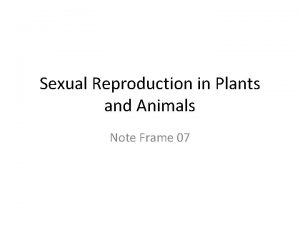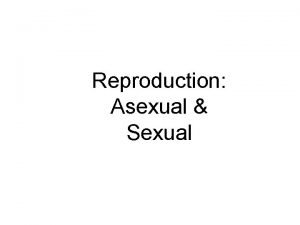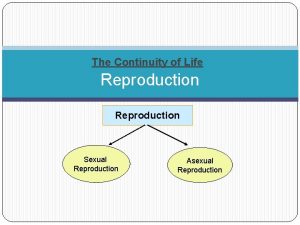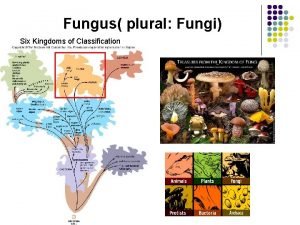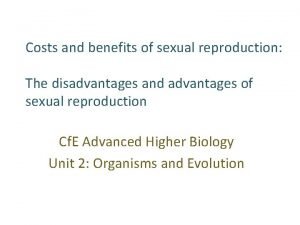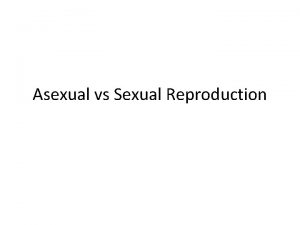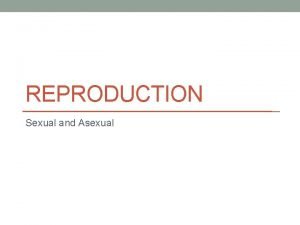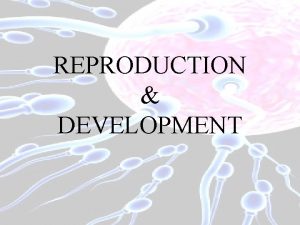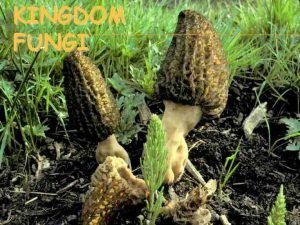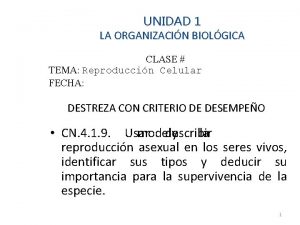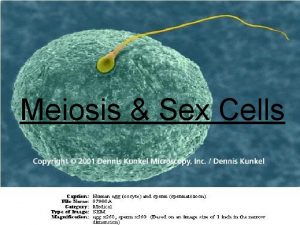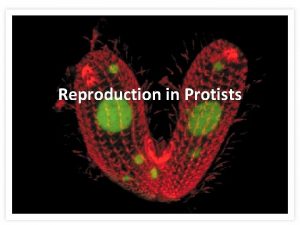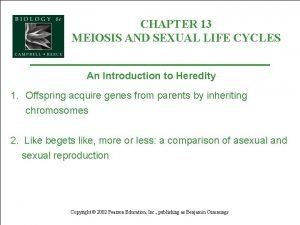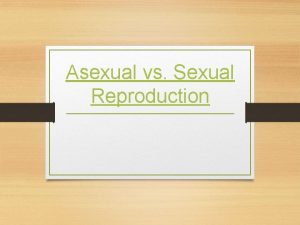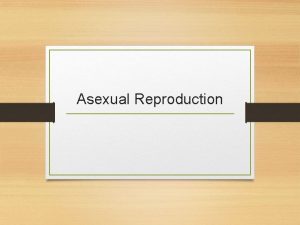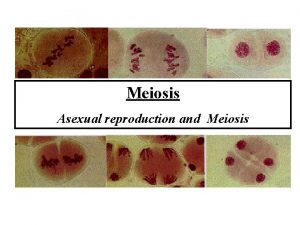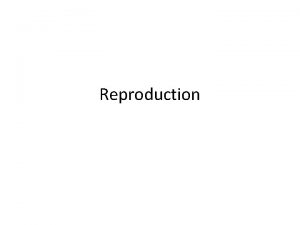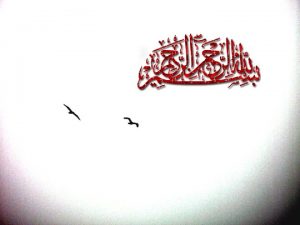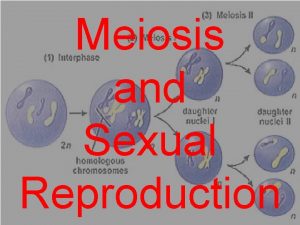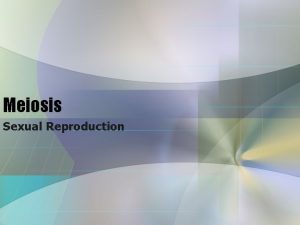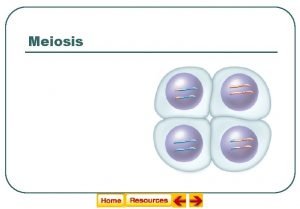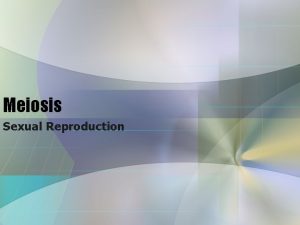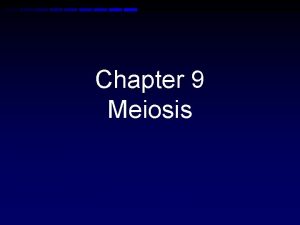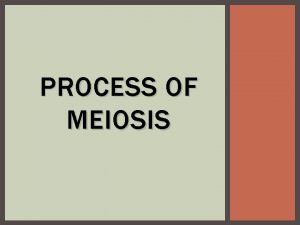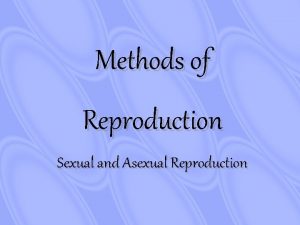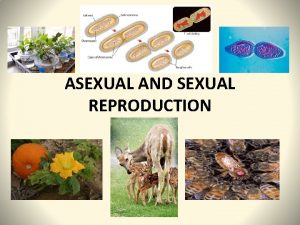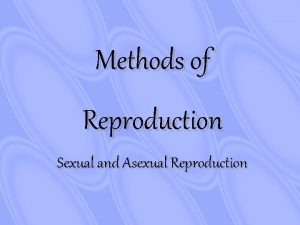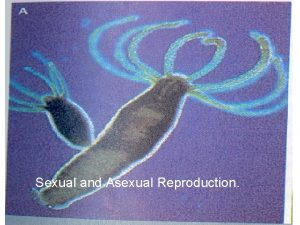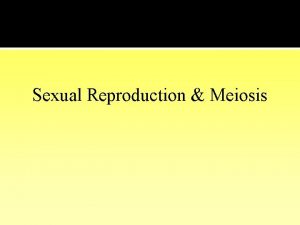Meiosis and Sexual Reproduction Ms Hughes Asexual Reproduction

























- Slides: 25

Meiosis and Sexual Reproduction Ms. Hughes

Asexual Reproduction � Reproduction -process of producing offspring(babies). � An individual formed by asexual reproduction is genetically identical to its parent. � Asexual reproduction 1 parent passes all of it’s traits to it’s offspring. ◦ Prokaryotes ◦ Star fish

Sexual Reproduction � sexual reproduction two parents give genetic material to produce offspring that are genetically different from the parents. � Each parent produces a reproductive cell called a gamete. � The gamete of one parent fuses with the gamete of another to form a zygote, this process is called fertilization.

Meiosis and gamete formation � Male animals produce gametes – sperm ◦ Male gametes go through meiosis to produce four sperm. � Female animals produce gametes – eggs ◦ Female gametes go through meiosis to produce four eggs however one will be larger than the other three which will not make it to maturity (only one egg per cycle)

� Germ cells (sperm/egg)are specialized for sexual reproduction. � Only germ cells can produce gametes. � All other body cells are called somatic cells. � Somatic cells have no participation in reproduction.

� Germ cells (from ovaries and testis) make gametes (sex cells aka egg and sperm) � Gamete (egg) + gamete (sperm) = zygote Fertilization

Advantages and Disadvantages of sexual and asexual reproduction Sexual Asexual Mate for companion Simple and Easy Produces a variety of traits Little energy is required this way Offspring are more likely to survive Fast and you only need 1 parent to a change because they are all do this slightly different Few offspring Many offspring Takes longer and requires more energy All offspring are identical so they are unlikely to survive a major disaster

Chromosome Number � Each chromosome has thousands of genes that play an important role in determining how an organism develops and functions. � Each organism must have a specific number of chromosomes or that organism will not develop properly.

Haploid vs. Diploid � Haploid – 1 set of chromosomes (gametes cells only) � Diploid – 2 sets of chromosomes (all other cells)


Homologous – 2 of the same chromosomes they will pair together (sister chromatids)

� Autosome – chromosomes that do not code for sex (22 pair) � Sex chromosomes – XY chromosomes that code for the sex/gender of an organism (1 pair)

Meiosis � Meiosis is a form of cell division that produces daughter cells with half the number of chromosomes that are in the parent cell. � During meiosis a diploid cell goes through two divisions to form four haploid cells.

Meiosis I Read page 251 in the book for further explanation

Comparing Meiosis and Mitosis � Mitosis makes new cells that are used during growth, development, and asexual reproduction. � Meiosis makes cells that enable an organism to reproduce sexually and happens only in reproductive structures.

Genetic Variation � Genetic Variation is made possible by sexual reproduction. � In sexual reproduction existing genes are rearranged. � Meiosis is the process that makes the rearranging of genes possible. Fusion of haploid cells from two different individuals adds further variation.

� Three are: key contributions to genetic variation ◦ crossing over ◦ independent assortment ◦ random fertilization.

Crossing Over � During prophase I, homologous chromosomes line up next to each other. � Each homologous chromosome is made of two sister chromatids attached at the centromere. � Crossing over happens when one arm of a chromatid crosses over the arm of the other chromatid. � Thus the sister chromatids of a homologous chromosome no longer have identical genetic information.

They now have completely different information!

Independent Assortment � metaphase I, homologous chromosomes line up. The two pairs of chromosomes can line up in two equally probable ways. � This random distribution of homologous chromosomes during meiosis is called independent assortment

Random Fertilization � Fertilization is a random process that adds genetic variation. � The zygote that forms is made by the random joining of two gametes.

Multicellular life cycles � All of the events in the growth and development of an organism until the organism reaches sexual maturity are called a life cycle. � Diploid � Haploid

Diploid Facts � Most animals have a diploid life cycle � Most of the life cycle is spent in the diploid state. � All of the cells except the gametes are diploid � A diploid germ cell in a reproductive organ goes through meiosis and forms haploid gametes. � Haploid gametes fuse to form a diploid zygote. � In diploid life cycles, meiosis in germ cells of a multicellular organism results in the formation of haploid gametes.

Haploid Life cycle � Mostly in fungi and protists � The zygote (the only diploid portion of the life cycle) goes through meiosis immediately after it is formed and makes new haploid cells. � In haploid life cycles, meiosis in a diploid zygote results in the formation of the first cell of a multicellular haploid individual.

Alternation of generation � Plants and most multicellular protists have a life cycle that alternates between a haploid phase and a diploid phase called alternation of generation. � The plant will produce haploid cells through meiosis that will reach maturity to fuse and form the diploid phase which will then produce haploid cells that will reach maturity and the cycle will repeat itself.
 Sexual reproduction and asexual reproduction
Sexual reproduction and asexual reproduction Sexual and asexual reproduction venn diagram
Sexual and asexual reproduction venn diagram Asexual reproduction vs sexual reproduction venn diagram
Asexual reproduction vs sexual reproduction venn diagram Synapsis and crossing over
Synapsis and crossing over Venn diagram of meiosis and mitosis
Venn diagram of meiosis and mitosis Asexual vs sexual reproduction venn diagram
Asexual vs sexual reproduction venn diagram Asexual reproduction cell division
Asexual reproduction cell division Sample example
Sample example Where does cactus store water
Where does cactus store water Parthenogenesis in mammals
Parthenogenesis in mammals Example of asexual
Example of asexual Asexual or sexual reproduction
Asexual or sexual reproduction Sexual or asexual reproduction
Sexual or asexual reproduction Plural form fungus
Plural form fungus Disadvantage of sexual reproduction
Disadvantage of sexual reproduction Sexual or asexual reproduction
Sexual or asexual reproduction Reproduction
Reproduction Asexual or sexual reproduction
Asexual or sexual reproduction Section 1 meiosis
Section 1 meiosis Sexual reproduction and genetics section 1 meiosis
Sexual reproduction and genetics section 1 meiosis Club fungi characteristics
Club fungi characteristics Etapas de la reproducción humana
Etapas de la reproducción humana Bacteria sexual or asexual
Bacteria sexual or asexual Protists
Protists Chapter 13 meiosis and sexual life cycles
Chapter 13 meiosis and sexual life cycles Chapter 13 meiosis and sexual life cycles
Chapter 13 meiosis and sexual life cycles








